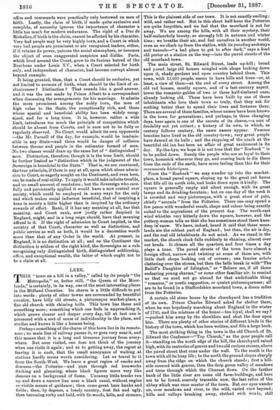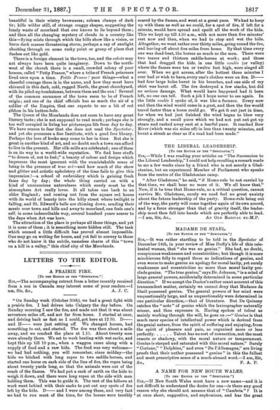LEEK.
THIS "town on a hill in a valley," called by its people "the Metropolis," or, better still, "the Queen of the Moor- lands," is certainly, in its way, one of the most interesting places in the Midland Counties. Its charm is a little difficult to put into words : plenty of other towns are surrounded by beautiful country, have billy old streets, a picturesque market-place, a fine old church with chiming bells. This town has these and something more; something which one feels in approaching it, which grows clearer and deeper every day, till at last one is possessed with a sort of sense of individuality in the place, and studies and knows it like a human being.
Perhaps something of the charm of this town lies in its remote- ness ; no main line of railway passes it, or goes very near it, and this means that it is a long and tiresome journey from every- where. But once visited, one does not think of the journey when one visits it again; and as to getting away, the regret at leaving it is such, that the small annoyance of waiting at stations hardly seems worth considering. Let us travel to it from the Sonth-West. We leave a great region of smoke and dimness—the Potteries—and pass through red ironworks flashing and gleaming, where black figures move very like demons on a background of flame. Uncanny little trucks run up and down a narrow line near a black canal, without engine or visible means of guidance ; then come great bare banks and fields ; then, by degrees, a lonely country, first flat and ugly. then becoming rocky and bold, with fir-woods, hills, and streams. This is the plainest side of our town. It is not exactly smiling ; wild, and rather sad. But in this short half-hour the Potteries are quite forgotten, and we feel that the moorland is not far away. We are among the hills, with all their mystery, their half-melancholy beauty, so strongly felt in autumn and winter time; we breathe their air, and feel ourselves in another world, even as we climb up from the station, with its puzzling archways and tunnels—" a bad place to get to after dark," says a kind old porter at a station on the way—into the paved streets of the old moorland town.
The main street, St. Edward Street, leads up-hill ; broad and paved, large old houses mingled with shops looking down upon it, shady gardens and open country behind them. This town, with 13,000 people, seems to have hills and trees—or, at least, a view of them—at the end of every street. Among the old red houses, mostly square, and of a last.century aspect, tower the romantic gables of two or three half-timbered ones, already looking old. These have been built by one of those inhabitants who love their town so truly, that they ask for nothing better than to spend their lives and fortunes there. There are several of these families, whose names have been known in the town for generations ; and perhaps, in these changing days, here again is one of the secrets of its charm,—a sort of feudality not yet extinct ; a history of its own, in which, as century follows century, the same names appear. Famous beauties have lived in the old country-town; very great people have danced at its balls ; and the stopping of the coach at the beautiful old inn has been an affair of great excitement in its day. By-the-bye, we hope it is not true that the" Roebuck " is to be pulled down. Surely the people who are so loyal to their town, homesick wherever they go, and coming back to die there from the ends of the earth, have more feeling than this for their monuments historiques.
From the " Roebuck " we may wander up into the market- place, a broad paved square, eloping up to the great red house that fills all its north side, and looks down upon it kindly. The square is generally empty and silent enough, with its great lamps and its drinking-fountain ; but on one day of the week it is crowded and very picturesque, with a great store of pots, chiefly " seconds " from the Potteries. There one may spend a few pence with wonderful result, shape and colour being exactly suited to the aspirations of the present day. The north-east wind whistles very bitterly down the square, however, and the pottery-woman tells us that she has sometimes stood there knee- deep in' snow. We have, indeed, heard it said that these moor- lands are the coldest part of England ; but then, the air is dry, and the real old inhabitants do not mind. As we stand in the market, the church clock falls suddenly to chiming, almost over our heads. It chimes all the quarters, and four times a day plays a tune. The paved streets of the town have alnsost a foreign effect, narrow and twisting as some of them are, with little dark shops looking out of corners ; one fancies sabots clattering over the stones, but then the bells break in with" The Bailiff's Daughter of Islington," or " Believe me, if all those endearing young charms," or some other familiar air, to remind us that we need not go abroad for that undefinable thing " romance," or poetic suggestion, or quaint picturesqueness; all are to be found in a Staffordshire moorland town, a dozen miles from the Potteries.
A certain old stone house by the churchyard has a tradition of its own. Prince Charles Edward asked for shelter there, when he was hopelessly marching about England in the winter of 1745, and the mistress of the house—too loyal, shall we say ? —pushed him away by the shoulders and shut the door upon him. There are plenty of other stories of different kinds in the history of the town, which has been written, and fills a large book.
The most striking thing in the town is the old Church of St. Edward the Confessor—" Top Church," as the poor people call it—standing on the north edge of the bill, the churchyard raised high, with its centuries of graves and two old curious crosses, above the paved street that runs under the wall. To the south is the town with all its busy life ; to the north the ground slopes sharply away from the ridge on which the church stands ; first a hill- side covered with graves, then the deep green valley of meadows and trees through which the Churoet flows. On the farther bank of the little river are some old farm-buildings, and here are to be found, scarcely traceable now, the last relics of the abbey which was once master of the town. But our eyes wander on, over meadows and river, to the wild, varied view beyond; hills and valleys breaking away, clothed with wools, still
beautiful in their wintry brownness; solemn clumps of dark br; hills wilder still, of strange craggy shapes, suggesting the lonely waste of moorland that one knows to lie beyond them ; and then all the changing mystery of clouds in a country like this—flying mists through which the hills show like a vision, or fierce dark masses threatening storm, perhaps a ray of sunlight shooting through on some rocky point or group of pines that flashes out like gold.
There is a foreign element in the town, too, and the sabots may not always have been quite imaginary. Down to the north- west of the church there is a small, crowded colony of poor houses, called "Petty France," where a tribe of French prisoners lived once upon a time. Petite France ! poor things—what a cheerful courage there is in the name, and how they must have shivered in this dark, cold, ragged North, the great churchyard, with its piled-up tombstones, between them and the sun ! Several of the common surnames of the town seem to be of French origin ; and one of its chief officials has so much the air of a soldier of the Empire, that one expects to see a bit of red ribbon in his button-hole.
The Queen of the Moorlands does not seem to have any great literary taste; she is not supposed to read much ; perhaps she is too well occupied in living her picturesque life from day to day. We have reason to fear that she does not read the Spectator; and yet she possesses a fine Institute, with a good free library. Perhaps the love of books may come to her in time. But she ie great in another kind of art, and no doubt such a town can afford to live in the present. Her silk-mills are celebrated; one of them is on its way to a world-wide reputation. We find here stuffs "to dream of, not to feel;" a beauty of colour and design which impresses the most ignorant with the unmistakable sense of being in the presence of true art—and how much of the show and glitter and artistic upholstery of the time fails to give this impression I—a school of embroidery which is gaining fresh fame day by day ; the whole thing carried on with a kind of unconscious naturalness which surely must be the atmosphere Art really loves. It all takes one back to an older England ; and coming out from the square red house with its world of beauty into the hilly street where twilight is falling, and St. Edward's bells are chiming down, sending their music over town and hills and away to moorland, one feels one's self, in some indescribable way, several hundred years nearer to the days when Art was born.
The attraction of the place is perhaps all these things, and yet it is none of them ; it is something more hidden still. The task which seemed a little difficult has proved almost impossible. One may go on writing for hours, and yet fail to convey to those who do not know it the subtle, nameleee charm of this "town on a hill in a valley," this chief city of the Moorlands.







































 Previous page
Previous page